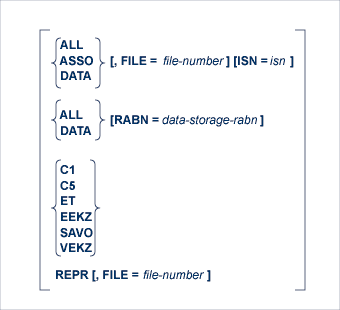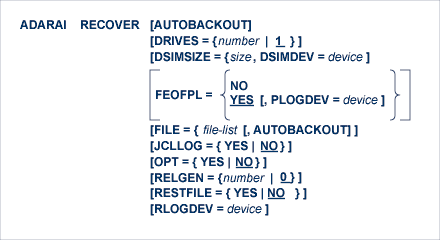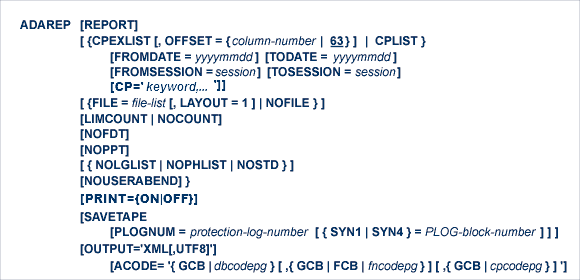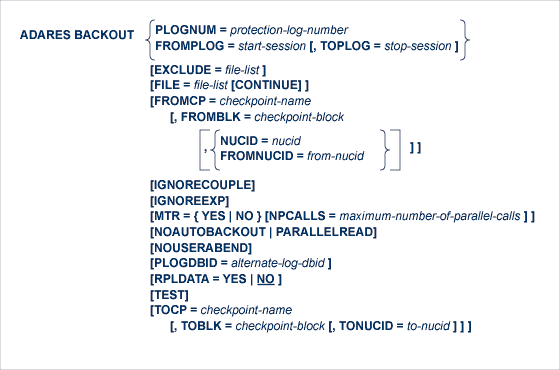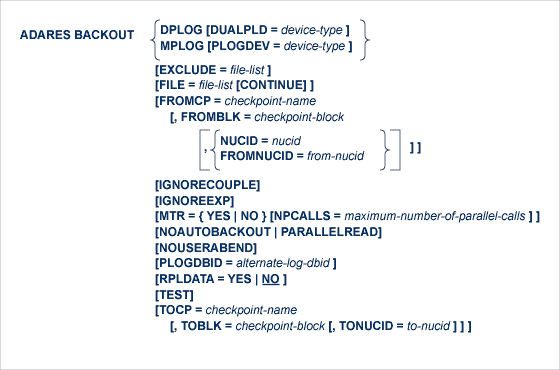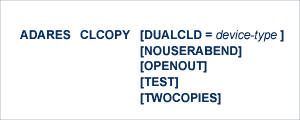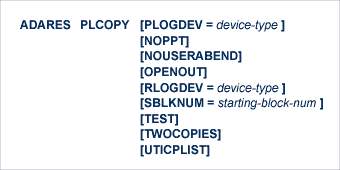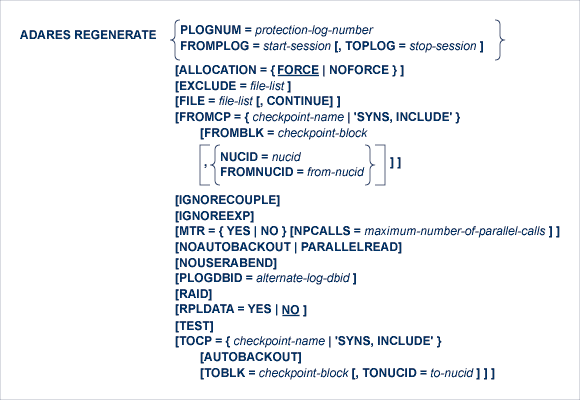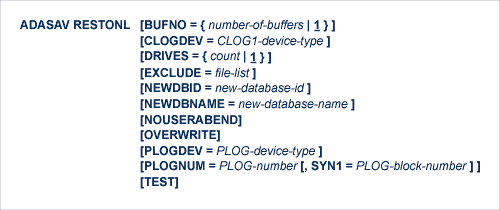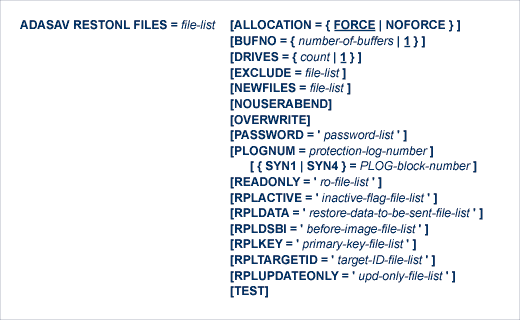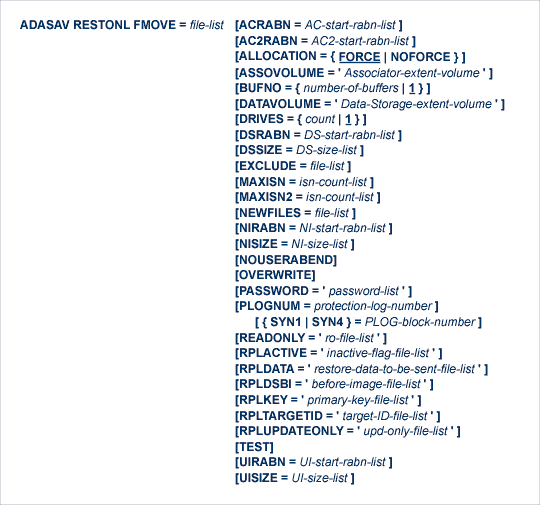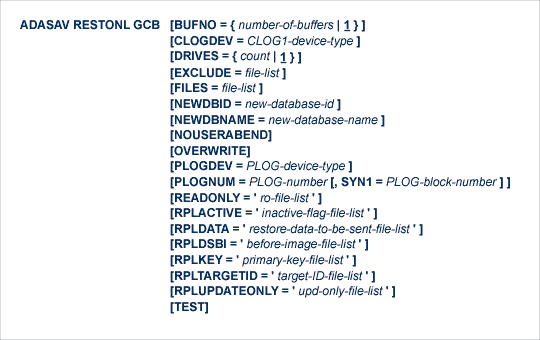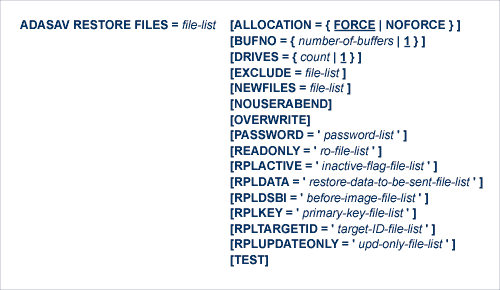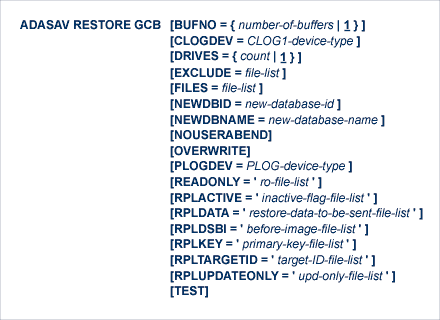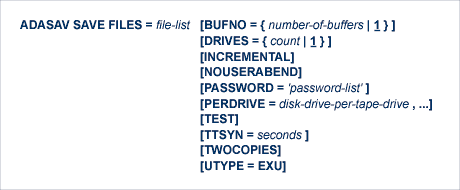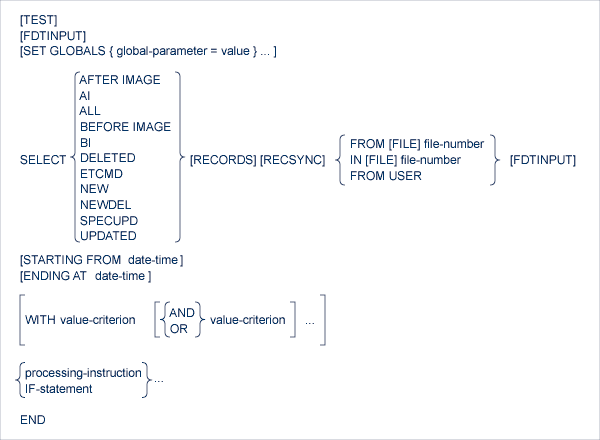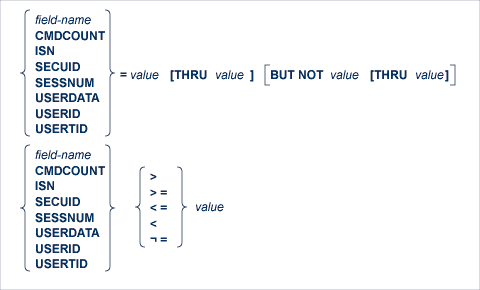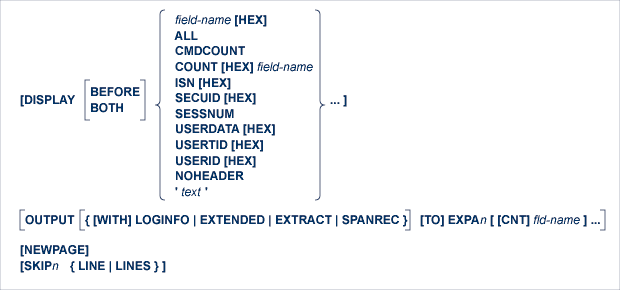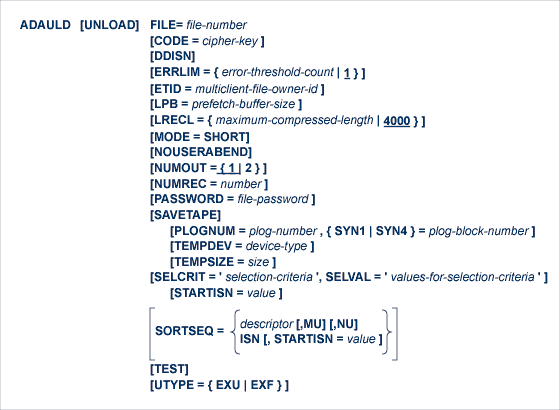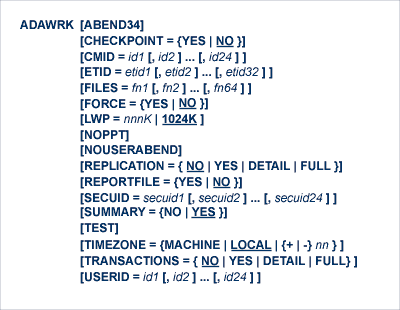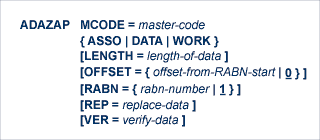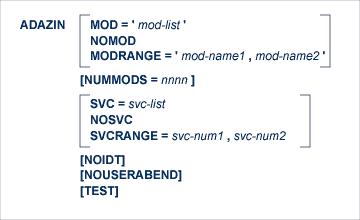| Utility Function | Use to... |
|---|---|
| ADACDC | Produce a file containing the delta of all changes made to the database over the period covered by the input protection logs. You can also use this utility to produce a file that lists each individual insert and delete transaction made to the database over the period covered by the input protection logs (without producing a delta of these changes). |
| ADACHK ACCHECK | Check the address converter for a specific file or range of files or for a specific ISN or range of ISNs. |
| ADACHK ASSOPRINT | Print the contents of any Associator (ASSO) block in the database. |
| ADACHK CHECK | Perform all ADACHK utility check functions. |
| ADACHK CLOGPRINT | Print the contents of any block or range of blocks in the command log (CLOG) data set. |
| ADACHK DATAPRINT | Print the contents of any block or range of blocks in Data Storage. |
| ADACHK DSCHECK | Check Data Storage and the Data Storage space table (DSST) of a specific file (or files) in the database. |
| ADACHK DSIMPRINT | Print the contents of any block or range of blocks in the Delta Save image (DSIM) data set. |
| ADACHK DSSTPRINT | Print the contents of the Data Storage Space Table (DSST). |
| ADACHK FCBPRINT | Print the contents of the file control block (FCB) for any file in the database. |
| ADACHK FDTPRINT | Print the contents of the field definition table (FDT) for any file in the database. |
| ADACHK FSTPRINT | Print the contents of the free space table (FST) for the database. |
| ADACHK GCBPRINT | Print the contents of the general control blocks (GCBs) for the database. |
| ADACHK ICHECK | Check the physical structure of the Associator. |
| ADACHK NIPRINT | Print the contents of the normal index of files or ranges of files in the database. |
| ADACHK PLOGPRINT | Print the contents of any block or range of blocks in the protection log (PLOG) data set. |
| ADACHK PPTPRINT | Print the contents of the parallel participant table (PPT) for the database. |
| ADACHK RLOGPRINT | Print the contents of any block or range of blocks in the recovery log (RLOG) data set. |
| ADACHK SORTPRINT | Print the contents of any block or range of blocks in the sort (SORT) data set. |
| ADACHK TEMPPRINT | Print the contents of any block or range of blocks in the temporary (TEMP) data set. |
| ADACHK UIPRINT | Print the contents of the upper index of files or ranges of files in the database. |
| ADACHK VALIDATE | Validate any or all files within an Adabas database, except the checkpoint and security files. |
| ADACHK WORKPRINT | Print the contents of any block or range of blocks in the work (WORK) data set. |
| ADACMP COMPRESS | Edit and compress data records that are to be loaded into the database. |
| ADACMP DECOMPRESS | Decompress individual files in the Adabas database. |
| ADACNV CONVERT | Convert a database to higher Adabas version. |
| ADACNV REVERT | Revert a database to a lower Adabas version. |
| ADADBS ADD | Add a new data set to the Associator or Data Storage. |
| ADADBS ADDCLOG | Dynamically add a command log (CLOG) data set |
| ADADBS ADDPLOG | Dynamically add a protection log (PLOG) data set |
| ADADBS ALLOCATE | Allocate an extent of a specific size for an address converter, Data Storage, or normal or upper index. |
| ADADBS CHANGE | Change the standard length or format of a field. |
| ADADBS CVOLSER | Print the Adabas file extents on a given volume. |
| ADADBS DEALLOCATE | Deallocate a file extent for an address converter, Data Storage, or normal index or upper index. |
| ADADBS DECREASE | Decrease the size of the last data set currently being used for the Associator or Data Storage. |
| ADADBS DELCLOG | Dynamically delete a command log (CLOG) data set |
| ADADBS DELCP | Delete checkpoint records. |
| ADADBS DELDE | Logically delete descriptors. |
| ADADBS DELETE | Delete a file from a database. |
| ADADBS DELFN | Logically delete fields from a database file. |
| ADADBS DELPLOG | Dynamically delete a protection log (PLOG) data set |
| ADADBS DEVENTLOG | Display the Adabas event log. |
| ADADBS DSREUSE | Activate or deactivate the reuse of Data Storage blocks for a file. |
| ADADBS ENCODEF | Change the file encoding of a file. |
| ADADBS EXPFILE | Insert or remove files in an expanded file chain. |
| ADADBS INCREASE | Increase the size of the last data set currently being used for the Associator or Data Storage. |
| ADADBS ISNREUSE | Reuse ISNs in a database. |
| ADADBS MODFCB | Modify various parameters for a non-system Adabas file. |
| ADADBS MUPEX | Set the maximum count for MU and PE fields in a database. |
| ADADBS NEWFIELD: | Add one or more fields to a file. |
| ADADBS ONLADD | Dynamically add a new Associator or Data Storage data set for the database. |
| ADADBS ONLINCREASE | Dynamically increase the size of the last existing Associator or Data Storage data set for the database. |
| ADADBS ONLINVERT | Start an online invert process. |
| ADADBS ONLREORFASSO | Start an online process to reorder the Associator of specified files. |
| ADADBS ONLREORFDATA | Start an online process to reorder the Data Storage of specified files. |
| ADADBS ONLREORFILE | Start an online process to reorder the Associator and Data Storage of specified files. |
| ADADBS OPERCOM | Issue operator commands to the Adabas nucleus. |
| ADADBS PRIORITY | Set or change the Adabas priority of a user. |
| ADADBS REACTLOG | Reactivate command logging. |
| ADADBS RECORDSPANNING | Enable or disable record spanning for a file. |
| ADADBS RECOVER | Recover allocated space by rebuilding the free space table (FST). |
| ADADBS REFRESH | Set a file to empty status. |
| ADADBS REFRESHSTATS | Reset the statistical values maintained by the Adabas nucleus for its current session. |
| ADADBS RELEASE | Release a descriptor from the descriptor space. |
| ADADBS RENAME | Rename a file or database. |
| ADADBS RENUMBER | Change the number of a file in the database. |
| ADADBS REPLICATION | Activate or deactivate replication for an Adabas database file. |
| ADADBS REPTOR | Activate, deactivate, open, or close an Event Replicator for Adabas resource. |
| ADADBS RESETDIB | Reset entries in the active utility list. |
| ADADBS RESETPPT | Resets the PPT blocks on the Associator data set. |
| ADADBS SPANCOUNT | Count and display the number of records in a file that are spanned. |
| ADADBS TRANSACTIONS | Suspend and resume update transaction processing for the database. |
| ADADBS UNCOUPLE | Uncouple files in the database. |
| ADADBS UNDELDE | Undelete logically deleted descriptors. |
| ADADBS UNDELFN | Logically undelete fields from a database file. |
| ADADEF DEFINE | Define a database and checkpoint file. |
| ADADEF MODIFY | Change field encodings. |
| ADADEF NEWWORK | Define a Work file. |
| ADADRU SPACEUSAGE | Produce summarized and detailed reports about database file space usage. |
| ADAFRM | Format Adabas database components. |
| ADAINV COUPLE | Define one descriptor for each of two files to be coupled. |
| ADAINV INVERT | Create descriptors, subdescriptors, superdescriptors, hyperdescriptors, phonetic descriptors or collation descriptors for existing fields in a file. |
| ADALOD LOAD | Load a file into the database. |
| ADALOD UPDATE | Add or delete a large number of records (ISNs) to or from an existing file. |
| ADAMER | Run the ADAM estimation. This utility produces statistics that indicate the number of Data Storage accesses required to find and read a record when using an ADAM descriptor. |
| ADAORD REORASSO | Reorder the Associator. |
| ADAORD REORDATA | Reorder Data Storage. |
| ADAORD REORDB | Reorder the database. |
| ADAORD REORFASSO | Reorder the Associator for a single file. |
| ADAORD REORFDATA | Reorder Data Storage for a single file. |
| ADAORD REORFILE | Reorder a file. |
| ADAORD RESTRUCTUREDB | Restructure the database. |
| ADAORD RESTRUCTUREF | Restructure single files. |
| ADAORD STORE: Store Files | Load one or more files into an existing database using output produced by the ADAORD RESTRUCTURE functions. |
| ADAPLP | Print data protection records from the protection log (PLOG) or Work data sets. |
| ADARAI CHKDB | Check that the recovery status of the nucleus is the status specified by the CHKDB function (active or inactive). |
| ADARAI DISABLE | Disable recovery logging by setting the RLOG table (control block) to inactive status. |
| ADARAI LIST | View the recovery log contents in table form. |
| ADARAI PREPARE | Initialize and start recovery logging to the recovery log. |
| ADARAI RECOVER | Build a recovery job stream for recovering the Adabas database or selected database files. |
| ADARAI REMOVE | Disable recovery logging by updating the Associator GCBs to indicate that recovery logging (that is, the Recovery Aid) is no longer active in the database, and that information will no longer be recorded in the recover log (RLOG). |
| ADAREP | Request a database status report. |
| ADARES BACKOUT SIBA | Back out updates applied between two specified checkpoints using the sequential protection log (SIBA). |
| ADARES BACKOUT DPLOG or MPLOG | Back out updates applied between two checkpoints contained on the same dual or multiple protection log. |
| ADARES CLCOPY | Copy the dual command log. |
| ADARES COPY | Copy a sequential protection log or save tape. |
| ADARES MERGE CLOG | Merge nucleus cluster command logs. |
| ADARES PLCOPY | Copy protection log data to a sequential data set. |
| ADARES REGENERATE | Reapply all the updates performed between two checkpoints. |
| ADARES REPAIR | Repair one or more Data Storage blocks, using the protection log and the output of the ADASAV utility. |
| ADASAV RESTONL | Restore a database from a database SAVE data set created while the Adabas nucleus was active. |
| ADASAV RESTONL FILES | Restore files to their original RABNs in an existing database. Files are restored from a file or database SAVE data set created while the Adabas nucleus was active. |
| ADASAV RESTONL FMOVE | Restore files to any free space in an existing database. Files are restored from a file or database SAVE data set created while the Adabas nucleus was active. |
| ADASAV RESTONL GCB | Restore the general control blocks (GCBs), Associator RABNs 3-30 of the database, the checkpoint file, the security file (if present), and all specified files. These file structures are restored from a database SAVE data set created while the Adabas nucleus was active. |
| ADASAV RESTORE | Restore a database from a database SAVE data set created while the Adabas nucleus was inactive. |
| ADASAV RESTORE FILES | Restore files to their original RABNs in an existing database. Files are restored from a file or database SAVE data set created while the Adabas nucleus was inactive. |
| ADASAV RESTORE FMOVE | Restore files to any free space in an existing database. Files are restored from a file or database SAVE data set created while the Adabas nucleus was inactive. |
| ADASAV RESTORE GCB | Restore the general control blocks (GCBs), Associator RABNs 3-30 of the database, the checkpoint file, the security file (if present), and all specified files. These file structures are restored from a database SAVE data set created while the Adabas nucleus was inactive. |
| ADASAV RESTPLOG | Restore changes contained in the protection log (PLOG) to the already restored database or files. |
| ADASAV SAVE | Save the contents of the database to a sequential data set. |
| ADASAV SAVE FILES | Save the contents of one or more files to a sequential data set. |
| ADASEL | Select and decompress information in the Adabas sequential (SIBA) or dual/multiple (PLOG) protection log and write it to a print data set (DDDRUCK/ DRUCK) or a user-specified output data set. |
| ADAULD UNLOAD FILE | Unload a specified Adabas file. |
| ADAWRK | Produce reports from records in the autorestart area of Work part 1. This information can be used when the database autostart fails and the database will not come up. It can help you determine how to handle database recovery. |
| ADAZAP | Display (in hexadecimal format) and optionally change the contents of the Associator, Data Storage, or Work data sets. |
| ADAZIN | Print Adabas maintenance and SVC information. |
| Field Definition Statements | Define or modify a field definition. Field definition statements can be specified in various Adabas utility functions. |
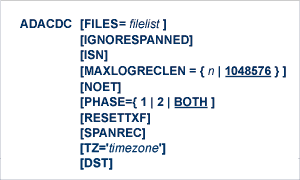
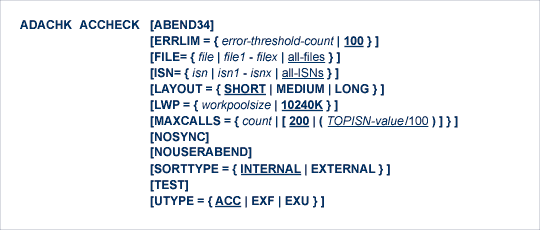

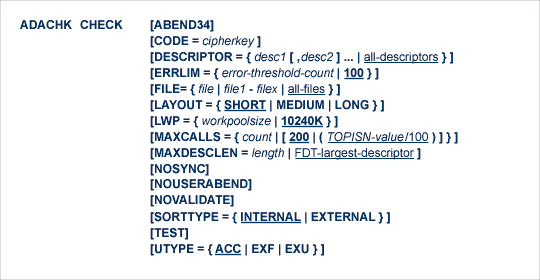
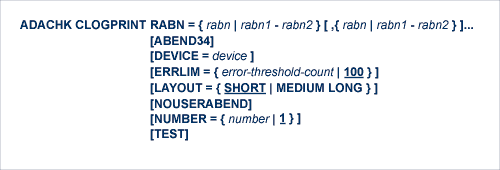








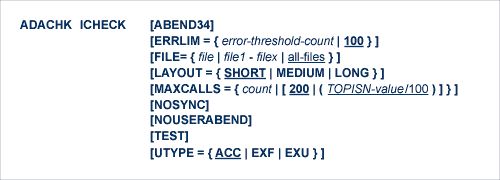

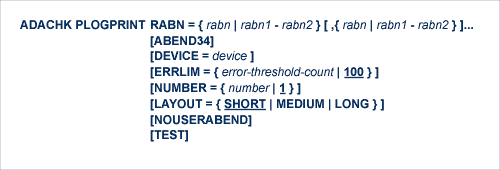





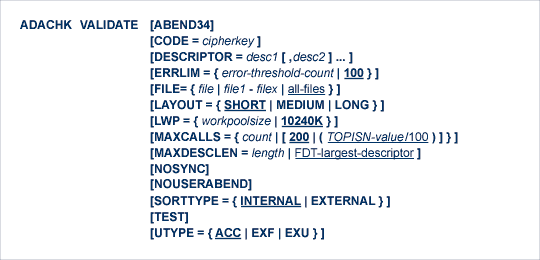

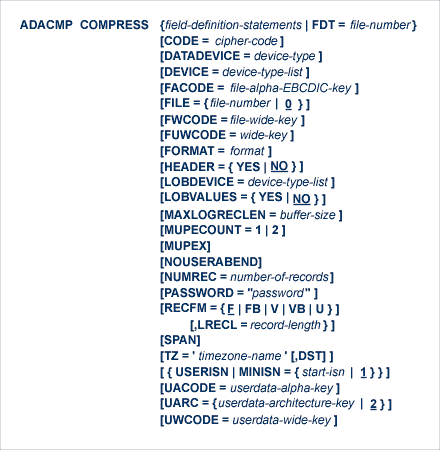
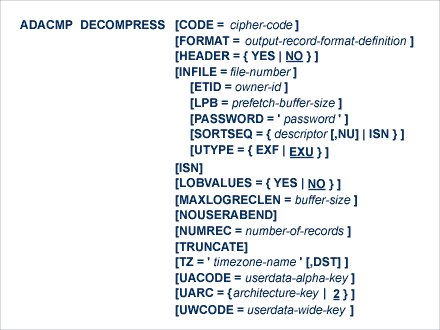
The following syntax must be followed when entering field definitions. A minimum of one and a maximum of 3214 definitions may be specified.
| Statement Type | Syntax |
|---|---|
| Field and Group |
|
| Periodic Group |
|
| Collation descriptor |
|
| Hyperdescriptor |
|
| Phonetic descriptor |
|
| Subdescriptor |
|
| Subfield |
|
| Superdescriptor |
|
| Superfield |
|
User comments may be entered to the right of each definition. At least one blank must be present between a definition and any user comments.



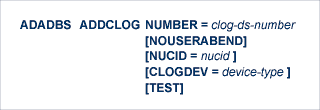
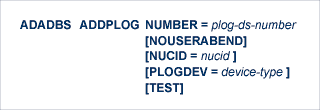







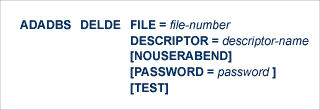

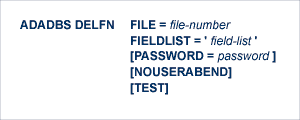




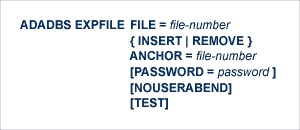


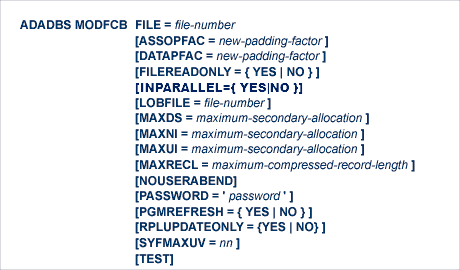
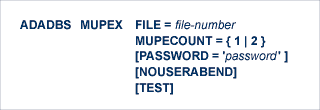



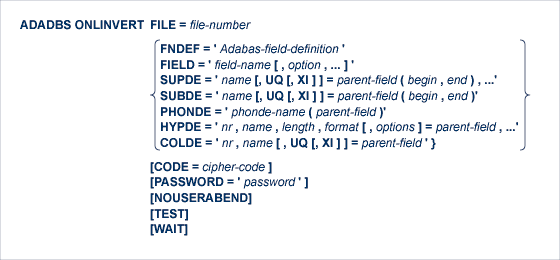

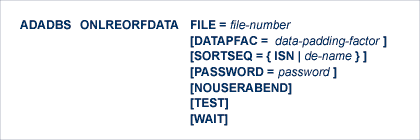
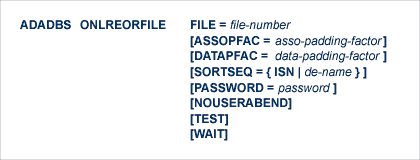
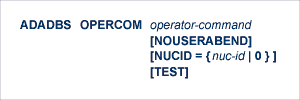
The following Adabas operator commands can be used in the ADADBS OPERCOM utility function:
- ADAEND Command
This command terminates an Adabas session normally. No new users are accepted after this command has been issued. ET logic updating is continued until the end of the current logical transaction for each user. After all activity has been completed as described above, the Adabas session is terminated.
In nucleus cluster environments, the GLOBAL option can be used to terminate the Adabas session in all active cluster nuclei.
- ALOCKF Command
Lock a file in advance to ensure that an EXU, EXF, or UTI user will have exclusive control of the specified file. The advance-lock prevents new transactions from using the file. Once all current users have stopped using the file, the exclusive-control user has the lock. Until then, the exclusive-control user must wait.
To remove the advance lock without running the utility, see the RALOCKF command.
This command is not available in single user mode or for a read-only nucleus. It is available in cluster and non-cluster environments.
The following key points should be noted about advance-locks on files:
An advance-lock can be set while a file is being used.
A command requesting exclusive control (UTI, EXF, or EXU) over an advance-locked file will wait in the command queue until all other users stop using the file before it starts processing the file.
Advance-locks are automatically removed when a user gets exclusive control over the file. However, if a file is locked (via the LOCKF, LOCKU, or LOCKX commands), the locks are not removed when a user gets exclusive control over the file. (Locks must be explicitly removed, whereas advance-locks are automatically removed.)
Adabas will reject an advance-lock on a file that is already locked (via the LOCKF, LOCKU, LOCKX or ALOCKF commands) but will accept a lock request on an advance-locked file.
To ensure you have uninterrupted exclusive control over a file in a situation where you have multiple steps to run that require uninterrupted exclusive control while all steps have been processed, use a combination of advance-locking the file (ALOCKF), stopping all users of the file (STOPF), and locking the file (LOCKU). An example of this is given later in this section.
In the case of expanded files, an ALOCKF command is applied to the anchor file (representing the entire expanded file chain).
In a cluster environment, advance-locks are effective in all nuclei of the cluster.
Simple Example
In the following example, issuing the ALOCKF request to advance-lock file 32 ensures that file 32 will be available so the ADALOD UPDATE function can take exclusive control (via a UTI request) of the file for its processing:
ADADBS OPERCOM ALOCKF=32 ADALOD UPDATE FILE=32Adabas processing proceeds in the following manner for these utility functions:
When the ADADBS OPERCOM ALOCKF request is submitted, file 32 is marked as advance-locked.
If there are any active users of file 32, the ADALOD UTI request cannot be granted immediately and will wait for the active users to end their transactions or sessions. Active users continue to issue commands against file 32. However, requests by new users for file 32 are rejected because of the advance-lock on the file.
When all active users of file 32 have ended their transactions or sessions, the ADALOD UTI request for exclusive control can be granted. Once exclusive control is established, ADALOD UPDATE processing can occur.
As part of the successful execution of the ADALOD UTI request, the advance-lock is removed from the file. However, because ADALOD processing now has exclusive control of file 32, other users still cannot access it.
To accelerate the process and limit the wait time for the ADALOD UTI request, you can simply stop all active users of the file by force using the STOPF operator command:
ADADBS OPERCOM ALOCKF=32 ADADBS OPERCOM STOPF=32 ADALOD UPDATE FILE=32In this case, the STOPF command will cause the nucleus to back out and stop users of file 32 before the ADALOD UTI request is granted. In addition, the advance-lock request specified by the ALOCKF command will prevent new users from accessing the file until the ADALOD UTI request for exclusive control is processed.
More Complex Example
An advance-lock set by ALOCKF cannot guarantee that multiple job steps in a series get uninterrupted exclusive control over a file, as the advance-lock is removed when the first step obtains exclusive control. Suppose an installation wants to run the following utility sequence:
ADAULD UNLOAD FILE=45 ADADBS REFRESH FILE=45 ADALOD UPDATE FILE=45An ALOCKF request to advance-lock file 45 in this case would only work for the ADAULD UNLOAD function, because the ADAULD EXU request for exclusive control of file 45 would remove the advance-lock. If there are active users who try to issue commands against file 45, there is a chance that one of them will execute a command between the UNLOAD and REFRESH steps, or between the REFRESH and UPDATE steps. Such a user may also prevent the REFRESH or UPDATE step from obtaining exclusive control of file 45.
To ensure you have uninterrupted exclusive control over the file in this situation, use a combination of advance-locking the file (ALOCKF), stopping all users of the file (STOPF), and locking the file (LOCKU):
ADADBS OPERCOM ALOCKF=45 ADADBS OPERCOM STOPF=45 ADADBS OPERCOM LOCKU=45 ADAULD UNLOAD FILE=45 ADADBS REFRESH FILE=45 ADALOD UPDATE FILE=45 ADADBS OPERCOM UNLOCKU=45In this example, Adabas processing proceeds in the following manner:
When the ADADBS OPERCOM ALOCKF request is submitted, file 45 is marked as advance-locked.
The ADADBS OPERCOM STOPF request causes the nucleus to back out and stop users of file 45. (This step is optional.)
The ADADBS OPERCOM LOCKU request locks the file more permanently than the ALOCKF request since the LOCKU lock will stay in effect until it is explicitly released.
If there are any active users updating file 45, the ADAULD EXU request cannot be granted immediately and will wait for the update users to end their transactions or sessions. Active users may continue to issue commands against file 45. However, requests by new users for file 45 are rejected because of the advance-lock on the file.
When all active users of file 45 have ended their transactions or sessions, the ADAULD request for exclusive-update (EXU) control can be granted. Once exclusive-update control is established, ADAULD UNLOAD processing can occur.
As part of the successful execution of the ADAULD EXU request, the advance-lock is removed from the file. When ADAULD completes processing, it releases the EXU control of file 45. However, during and after the ADAULD execution, the LOCKU lock ensures that other users still cannot access the file.
The ADADBS utility will issue a UTI request for exclusive control of file 45, which will be granted. ADADBS REFRESH processing will then occur. When it completes, ADADBS will release exclusive control of file 45. However, the LOCKU lock ensures that other users still cannot access it.
The ADALOD utility will issue a UTI request for exclusive control of file 45, which will be granted. ADALOD UPDATE processing will then occur. When it completes, ADALOD will release exclusive control of file 45. However, the LOCKU lock ensures that other users still cannot access it.
The ADADBS OPERCOM UNLOCKU request explicitly unlocks file 45, making it available for other users.
- ASSOSPACEWARN Command
Use the ASSOSPACEWARN command to modify the setting of the ASSOSPACEWARN ADARUN parameter while the database is running. ASSOSPACEWARN specifies up to three pairs of threshold percentages and percentage change increments, expressed as percentages of the total Associator (ASSO) portion of the database. When ASSO space use reaches a specified threshold percentage, a space usage message is issued. In addition, when the ASSO space use changes by the increment specified for that threshold, additional space usage messages are issued.
Note:
For the purposes of database space notifications, the space used in the Adabas database comprises all database blocks that have been assigned either to some common purpose (for example, DSST, PPT, DLOG area) or to a file in the database. Only space listed in the free space table (FST) is not calculated as used. In particular, free space allocated for some file but not yet used is calculated as used.The following specifications can be made in the ASSOSPACEWARN command:
Parameter Description threshold# A threshold, expressed as a percentage of the total Associator portion of the database. When ASSO space use exceeds or falls below any of the thresholds set, a space usage message is issued. The default is zero (0). If zero is specified for the first threshold setting, no space messages are issued. When more than one threshold is specified, the second threshold specification must be greater than the first. Likewise, the third threshold specification (if made) must be greater than the second.
inc# An increment percentage, expressed as a percentage of the total ASSO portion of the database. When ASSO space use changes (increases or decreases) from the associated threshold by the amount given in this increment percentage, another space usage message is issued. The default is five percent (5). Up to three threshold-increment pairs can be specified.
- AUDCONNECT Command
Use this command to dynamically force a connection attempt to either a specific Auditing Server or Adabas database ID, or to all related Auditing Server or Adabas database IDs.
One of the parameters of the AUDCONNECT command must be specified. There is no default. The parameters are described in the following table:
Parameter Description ALL Forces a reconnection attempt with ALL known Auditing Server or Adabas database IDs. dbid The specified Auditing Server or Adabas database ID. - AUDITLOG Command
Use the AUDITLOG command to modify the setting of the AUDITLOG ADARUN parameter while the database is running. Valid option is "CONSOLE". Once AUDITLOG has been activated with "CONSOLE", it cannot be changed to "NO" without cycling the nucleus.
In the following example, issuing the AUDITLOG requests activates the AUDITLOG to start writing all utility, and AOS audit data to the console.
ADADBS OPERCOM AUDITLOG=CONSOLE- AUTOINCASSOSIZE Command
Use the AUTOINCASSOSIZE command to modify the setting of the AUTOINCASSOSIZE ADARUN parameter while the database is running. AUTOINCASSOSIZE specifies the size, in cylinders or blocks, by which the highest-numbered (last-defined) Associator (ASSO) data set will be increased by an automatic database increase process.
This parameter only has an effect if the AUTOINCASSOTHRESHOLD setting has a non-zero value. A numeric value followed by the letter B indicates the value specifies a number of blocks, which is then rounded up to the next highest amount that fills the final track or other platform-dependent minimum space allocation unit. A numeric value without the suffix B indicates the increment is in cylinders.
If an automatic database increase process is started to increase the ASSO component of the database, the last ASSO container data set will be increased by the number of cylinders or blocks specified by AUTOINCASSOSIZE. (The number of cylinders or blocks added may be less, however, if the limit set by the AUTOINCASSOTOTAL parameter is reached.)
If the last ASSO container data set cannot be increased by the specified size, but only by a lesser amount, the automatic increase process will increase the data set by the amount of space that it can get. Note that one data set can span at most 59 volumes with up to 16 extents on each volume. When these limits are reached, the database should be increased manually by adding a new container data set with the ADADBS ONLADD utility function.
When 4-byte RABNs are used, valid values for this parameter range from zero (0) to 2147483647 cylinders or from zero (0) to 2147483647B blocks. When 3-byte RABNs are used, the limits range from zero (0) to 16775215 blocks or the equivalent in cylinders. A value of "0" or "0B" means that no automatic increase will be performed for ASSO space. The default value for this parameter is zero, which functionally disables auto-increase for ASSO space.
If AUTOINCASSOSIZE is set to a small value, the automatic database increase process may be initiated multiple times and cause the container allocation to reach platform-dependent limits on extents and volumes. Once that occurs, there can be no more auto-increases until the container allocations are consolidated, which requires stopping all nuclei using the container. Alternatively, a manual increase can be used to add another container without stopping the Adabas nucleus.
- AUTOINCASSOTHRESHOLD Command
Use the AUTOINCASSOTHRESHOLD command to modify the setting of the AUTOINCASSOTHRESHOLD ADARUN parameter while the database is running. AUTOINCASSOTHRESHOLD specifies the Associator space threshold at which Adabas automatically initiates a database increase process. This threshold is expressed as a percentage of used Associator (ASSO) space to total Associator space available in the database, ASSO space is considered used if it is not listed as free in the Free Space Table (FST).
If the used Associator space exceeds the percentage defined by the specified AUTOINCASSOTHRESHOLD setting, Adabas automatically initiates a database increase process for ASSO space.
Note that the database increase process may take some time, the length of which is related to the size by which the database is increased (the value of the AUTOINCASSOSIZE setting). The AUTOINCASSOTHRESHOLD setting should be configured so that the increase process is given sufficient time to complete before the database fills up, assuming a reasonable space consumption rate.
Once a database increase process has been initiated, another automatic increase for ASSO space may be started only after the first process has finished and the ASSO space usage again or still exceeds the specified threshold.
Valid values for this command are either zero (0) or integers ranging from 50 through 100. A value of zero means that no automatic increase will be performed for ASSO space. A value of 100 means that an automatic increase process will be initiated only when the ASSO space grows full (i.e., no free space is left at all). The default value is zero, which functionally disables auto-increase processes for ASSO space.
- AUTOINCASSOTOTAL Command
Use the AUTOINCASSOTOTAL command to modify the setting of the AUTOINCASSOTOTAL ADARUN parameter while the database is running. AUTOINCASSOTOTAL specifies the maximum total size, in cylinders or blocks, of the entire Associator space of the database that is not to be exceeded by automatic database increase processes.
A numeric value followed by the letter B indicates the value specifies a number of blocks, which is then rounded up to the next highest amount that fills the final track or other platform-dependent minimum space allocation unit. A numeric value without a suffix B indicates the increment is in cylinders.
An automatic database increase process for ASSO space will not exceed the size specified by the AUTOINCASSOTOTAL setting. This setting can be used to limit the total amount of disk space used for the database, in order to protect the disk space remaining available for other databases and other users of the system. Note that this setting limits only automatic increases by Adabas; it does not limit increasing the database manually using the ADADBS ADD, INCREASE, ONLADD or ONLINCREASE utility functions.
AUTOINCASSOTOTAL specifies the number of cylinders or blocks beyond which automatic database increase processes will not extend the ASSO space of the database. If the AUTOINCASSOTOTAL setting is less than the current number of cylinders in the ASSO space plus the AUTOINCASSOSIZE value, an automatic increase will increase the ASSO space only by the difference between the AUTOINCASSOTOTAL value and the current size – that is, by less than the increase requested by the AUTOINCASSOSIZE setting. If AUTOINCASSOTOTAL is not greater than the current number of cylinders in ASSO, no further automatic increases will be performed for ASSO space.
When 4-byte RABNs are used, valid values for this parameter range from zero (0) to 2147483647 cylinders or from zero (0) to 2147483647B blocks. When 3-byte RABNs are used, the limits range from zero (0) to 16775215 blocks or the equivalent in cylinders. A value of "0" or "0B" means that no automatic increase will be performed for ASSO space. The default value for this parameter is zero, which functionally disables auto-increase for ASSO space.
The total size of ASSO space may be constrained to less than the AUTOINCASSOTOTAL value for either of the following reasons.
There may not be enough storage resources to extend to the specified limit.
When using 4-byte RABNs, a component can have at most 2147483647 blocks, and for 3-byte RABNs the limit is 16777215 blocks.
- AUTOINCDATASIZE Command
Use the AUTOINCDATASIZE command to modify the setting of the AUTOINCDATASIZE ADARUN parameter while the database is running. AUTOINCDATASIZE specifies the size, in cylinders or blocks, by which the highest-numbered (last-defined) Data Storage (DATA) data set will be increased by an automatic database increase process.
This parameter only has an effect if the AUTOINCDATATHRESHOLD has a non-zero value. A numeric value followed by the letter B indicates the value specifies a number of blocks, which is then rounded up to the next highest amount that fills the final track or other platform-dependent minimum space allocation unit. A numeric value without the suffix B indicates the increment is in cylinders.
If an automatic database increase process is started to increase the DATA component of the database, the last DATA container data set will be increased by the number of cylinders or blocks specified by AUTOINCDATASIZE. (The number of cylinders or blocks added may be less, however, if the limit set by the AUTOINCDATATOTAL parameter is reached.)
If the last ASSO container data set cannot be increased by the specified size, but only by a lesser amount, the automatic increase process will increase the data set by the amount of space that it can get. Note that one data set can span at most 59 volumes with up to 16 extents on each volume. When these limits are reached, the database should be increased manually by adding a new container data set with the ADADBS ONLADD utility function.
When 4-byte RABNs are used, valid values for this parameter range from zero (0) to 2147483647 cylinders or from zero (0) to 2147483647B blocks. When 3-byte RABNs are used, the limits range from zero (0) to 16775215 blocks or the equivalent in cylinders. A value of "0" or "0B" means that no automatic increase will be performed for DATA space. The default value for this parameter is zero, which functionally disables auto-increase for DATA space.
If AUTOINCDATASIZE is set to a small value, the automatic database increase process may be initiated multiple times and cause the container allocation to reach platform-dependent limits on extents and volumes. Once that occurs, there can be no more auto-increases until the container allocations are consolidated, which requires stopping all nuclei using the container. Alternatively, a manual increase can be used to add another container without stopping the Adabas nucleus.
- AUTOINCDATATHRESHOLD Command
Use the AUTOINCDATATHRESHOLD command to modify the setting of the AUTOINCDATATHRESHOLD ADARUN parameter while the database is running. AUTOINCDATATHRESHOLD specifies the Data Storage space threshold at which Adabas automatically initiates a database increase process. This threshold is expressed as a percentage of used Data Storage space to total Data Storage space available in the database. DATA space is considered used if it is not listed as free in the Free Space Table (FST).
If the used Data Storage space exceeds the percentage defined by the specified AUTOINCDATATHRESHOLD setting, Adabas automatically initiates a database increase process for DATA space.
Note that the database increase process may take some time, the length of which is related to the size by which the database is increased (the value of the AUTOINCDATASIZE setting). The AUTOINCDATATHRESHOLD setting should be configured so that the increase process is given sufficient time to complete before the database fills up, assuming a reasonable space consumption rate.
Once a database increase process has been initiated, another automatic increase for DATA space may be started only after the first process has finished and the DATA space usage again or still exceeds the specified threshold.
Valid values for this command are either zero (0) or integers ranging from 50 through 100. A value of zero means that no automatic increase will be performed for DATA space. A value of 100 means that an automatic increase process will be initiated only when the DATA space grows full (i.e., no free space is left at all). The default value is zero, which functionally disables auto-increase processes for DATA space.
- AUTOINCDATATOTAL Command
Use the AUTOINCDATATOTAL command to modify the setting of the AUTOINCDATATOTAL ADARUN parameter while the database is running. AUTOINCDATATOTAL specifies the maximum total size, in cylinders or blocks, of the entire Data Storage space of the database that is not to be exceeded by automatic database increase processes.
A numeric value followed by the letter B indicates the value specifies a number of blocks, which is then rounded up to the next highest amount that fills the final track or other platform-dependent minimum space allocation unit. A numeric value without a suffix B indicates the increment is in cylinders.
An automatic database increase process for DATA space will not exceed the size specified by the AUTOINCDATATOTAL setting. This setting can be used to limit the total amount of disk space used for the database, in order to protect the disk space remaining available for other databases and other users of the system. Note that this setting limits only automatic increases by Adabas; it does not limit increasing the database manually using the ADADBS ADD, INCREASE, ONLADD or ONLINCREASE utility functions.
AUTOINCDATATOTAL specifies the number of cylinders or blocks beyond which automatic database increase processes will not extend the DATA space of the database. If AUTOINCDATATOTAL setting is less than the current DATA size plus the AUTOINCDATASIZE value, an automatic increase will increase the DATA space only by the difference between the AUTOINCDATATOTAL value and the current size – that is, by less than the increase requested by the AUTOINCDATASIZE setting. If the AUTOINCDATATOTAL setting is not greater than the current DATA size, no further automatic increases will be performed for DATA space.
When 4-byte RABNs are used, valid values for this parameter range from from zero (0) to 2147483647 blocks or the equivalent in cylinders. When 3-byte RABNs are used, the limits range from zero (0) to 16775215 blocks or the equivalent in cylinders. A value of "0" or "0B" means that no automatic increase will be performed for DATA space. The default value for this parameter is zero, which functionally disables auto-increase for DATA space.
The total size of DATA space may be constrained to less than the AUTOINCDATATOTAL value for either of the following reasons.
There may not be enough storage resources to extend to the specified limit.
When using 4-byte RABNs, a component can have at most 2147483647 blocks, and for 3-byte RABNs the limit is 16777215 blocks.
- CANCEL Command
Cancel the Adabas session immediately. All command processing is immediately suspended. A pending autorestart is in effect which in turn causes the autorestart routine to be executed during the initialization of the next Adabas session.
In nucleus cluster environments, the GLOBAL option can be used to cancel the Adabas session in all active cluster nuclei.
- CLOGMRG Command
Switches automatic command log merging (ADARUN CLOGMRG parameter value) on or off in nucleus cluster environments.
The CLOGMRG command is global by definition and affects all nuclei in the cluster. If a NUCID is specified, it is ignored.
- CLUPUBLPROT Command
Use the CLUPUBLPROT command to dynamically modify the setting of the ADARUN CLUPUBLPROT parameter. For more information, read CLUPUBLPROT Parameter: Publishing of Protection Data.
The CLUPUBLPROT command is only valid in cluster environments. It is global by definition and affects all nuclei in the cluster. If a NUCID is specified, it is ignored.
- CT Command
Dynamically override the ADARUN CT parameter value; that is, the maximum number of seconds that can elapse from the time an Adabas command has been completed until the results are returned to the user through interregion communication (which depends on the particular operating system being used). The minimum setting is 1; the maximum is 16777215.
In nucleus cluster environments, the CT command is global by definition and affects all nuclei in the cluster. If a NUCID is specified, it is ignored.
- DATASPACEWARN Command
Use the DATASPACEWARN command to modify the setting of the DATASPACEWARN ADARUN parameter while the database is running. DATASPACEWARN specifies up to three pairs of threshold percentages and percentage change increments, expressed as percentages of the total Data Storage (DATA) portion of the database. When Data Storage space use reaches a specified threshold percentage, a space usage message is issued. In addition, when the Data Storage space use changes by the increment specified for that threshold, additional space usage messages are issued.
Note:
For the purposes of database space notifications, the space used in the Adabas database comprises all database blocks that have been assigned either to some common purpose (for example, DSST, PPT, DLOG area) or to a file in the database. Only space listed in the free space table (FST) is not calculated as used. In particular, free space allocated for some file but not yet used is calculated as used.The following specifications can be made in the DATASPACEWARN command:
Parameter Description threshold# A threshold, expressed as a percentage of the total Data Storage (DATA) portion of the database. When DATA space use exceeds or falls below any of the thresholds set, a space usage message is issued. The default is zero (0). If zero is specified for the first threshold setting, no space messages are issued. When more than one threshold is specified, the second threshold specification must be greater than the first. Likewise, the third threshold specification (if made) must be greater than the second.
inc# An increment percentage, expressed as a percentage of the total DATA portion of the database. When DATA space use changes (increases or decreases) from the associated threshold by the amount given in this increment percentage, another space usage message is issued. The default is five percent (5). Up to three threshold-increment pairs can be specified.
- DAUQ Command
Display the user queue element (UQE) of each user who has executed at least one Adabas command within the last 15 minutes. Up to 100 user queue elements will be displayed.
In nucleus cluster environments, the NUCID=0 option can be used to display information for all active cluster nuclei. Information is displayed for each nucleus, one after the other.
- DCMDSTAT Command
Display statistics about the usage distribution of commands by command type.
Here is sample output from the DCMDSTAT operator command when run using the ADADBS OPERCOM utility function:
ADADBS OPERCOM DCMDSTAT Type Commands -------------------------- A1/4 527,017 CL 3 ET 28 HI 528,086 L2/5 20,784,748 L3/6 9,977,842 N1/2 282 OP 3 UC 3 REST 1 -------------------------- Total 31,818,013- DCQ Command
Display all posted command queue elements (CQEs). Each CQE's user ID, job name, and buffer length is displayed.
In nucleus cluster environments, the NUCID=0 option can be used to display information for all active cluster nuclei. Information is displayed for each nucleus, one after the other. Here is sample output from the DCQ operator command run using the ADADBS OPERCOM utility function:
User/Terminal-ID Jobname SECUID Time Status Cmd File Length -------------------------------------------------------------------------- 'Z007Z007' ABCTPCTA ABC 13:36:14 Done L3 27 1664 'Z019Z019' ABCTPCTA ABC 13:36:14 Ready A1 21 1388 C90060C839F60000 ABCDCQ ABC 13:36:14 Active LA 0 720- DDIB Command
Display data integrity block (DIB). This block contains entries indicating which Adabas utilities are active and the resources being used by each utility. The DDIB function can be performed with either an active or an inactive nucleus.
In nucleus cluster environments, the information displayed by the DDIB command is global; the command can be run on any nucleus.
- DDSF Command
Display Adabas Delta Save Facility Facility (DSF) status. The Adabas nucleus displays the DSF status on the operator console as well as in the ADADBS job protocol.
This function is only available if the nucleus is run with the parameter ADARUN DSF=YES.
In nucleus cluster environments, the information displayed by the DDSF command is global; the command can be run on any nucleus.
- DFILES Command
Displays the number of access, update, EXU, and UTI users for the specified files. User types are totaled for each file, and are listed by file. Up to five files can be specified in this command. Up to 798 users are displayed.
In nucleus cluster environments, the NUCID=0 option can be used to display information for all active cluster nuclei. Information is displayed for each nucleus, one after the other. Here is sample output from the DFILES operator command run using the ADADBS OPERCOM utility function:
U E U A T X P C File I U D C User User/Terminal-ID Jobname SECUID ETID ----------------------------------------------------------------------------- 11 1 0 1 1 00008ACB C9108B278FF52000 ABCLOD ABC 12 0 1 0 1 00008BF3 C9108CF0F4E09000 ABC ABC 23 0 0 14 17 00008EC7 'Z001Z001' ABCTPCTA ABC Z01-ETID 00008EC8 'Z002Z002' ABCTPCTA ABC Z02-ETID 00008EC9 'Z003Z003' ABCTPCTA ABC Z03-ETID 00008ECA 'Z004Z004' ABCTPCTA ABC Z04-ETID 00008ECB 'Z005Z005' ABCTPCTA ABC Z05-ETID 00008ECC 'Z006Z006' ABCTPCTA ABC Z06-ETID 00008ECE 'Z007Z007' ABCTPCTA ABC Z07-ETID 00008ECF 'Z008Z008' ABCTPCTA ABC Z08-ETID 00008ED0 'Z009Z009' ABCTPCTA ABC Z09-ETID 00008ED1 'Z010Z010' ABCTPCTA ABC Z10-ETID 00008ED2 'Z011Z011' ABCTPCTA ABC Z11-ETID 00008ED3 'Z012Z012' ABCTPCTA ABC Z12-ETID 00008ED5 'Z013Z013' ABCTPCTA ABC Z13-ETID 00008ED8 'Z014Z014' ABCTPCTA ABC Z14-ETID 00008ED9 'Z015Z015' ABCTPCTA ABC Z15-ETID 00008EDA 'Z016Z016' ABCTPCTA ABC Z16-ETID 00008EDB 'Z017Z017' ABCTPCTA ABC Z17-ETID- DFILESTAT Command
- DFILUSE Command
Displays the count of commands processed for the specified file so far during the current session.
In nucleus cluster environments, the NUCID=0 option can be used to display information for all active cluster nuclei. Information is displayed for each nucleus, one after the other.
- DHQA Command
Display all hold queue elements (HQEs) and all users of each element.
Here is sample output from the DHQA operator command run using the ADADBS OPERCOM utility function:
File ISN Mode User User/Terminal-ID Jobname SECUID ETID ----------------------------------------------------------------------------- 10 1 SHR 000072A1 'U001U001' ABCTXG ABC SHR 000072A2 'U002U002' ABCTXG ABC SHR 000072A3 'U003U003' ABCTXG ABC SHR 000072A4 'U004U004' ABCTXG ABC SHR 000072A5 'U005U005' ABCTXG ABC SHR 000072A6 'U006U006' ABCTXG ABC SHR 000072A7 'U007U007' ABCTXG ABC SHR 000072A8 'U008U008' ABCTXG ABC 11 10 SHR 000072D6 C90F5F4552580000 SILLYJOB 22 2 EXCL 000072E8 'Z001Z001' ABCTPCTA ABC Z01-ETID 22 3 EXCL 000072E2 'Z002Z002' ABCTPCTA ABC Z02-ETID 22 5 EXCL 22 7 EXCL 000072E9 'Z005Z005' ABCTPCTA ABC Z05-ETID 22 10 EXCL 000072F0 'Z008Z008' ABCTPCTA ABC Z08-ETID 22 12 EXCL 000072E3 'Z003Z003' ABCTPCTA ABC Z03-ETID 22 15 EXCL 000072ED 'Z009Z009' ABCTPCTA ABC Z09-ETID 23 4783 EXCL 000072F3 'Z011Z011' ABCTPCTA ABC Z11-ETID ... 29 108191 EXCL 000072E4 'Z004Z004' ABCTPCTA ABC Z04-ETID 29 113431 EXCL 000072E4 'Z004Z004' ABCTPCTA ABC Z04-ETID 29 113823 EXCL 000072E4 'Z004Z004' ABCTPCTA ABC Z04-ETID 29 129953 EXCL 000072E4 'Z004Z004' ABCTPCTA ABC Z04-ETID 29 164217 EXCL 000072E4 'Z004Z004' ABCTPCTA ABC Z04-ETID 29 171617 EXCL 000072E4 'Z004Z004' ABCTPCTA ABC Z04-ETID 29 181868 EXCL 000072E4 'Z004Z004' ABCTPCTA ABC Z04-ETID 29 197793 EXCL 000072E4 'Z004Z004' ABCTPCTA ABC Z04-ETID- DLOCKF Command
Display locked files. The type of lock appears in parentheses following the file number. Possible file types are:
Type Description F The file was locked by LOCKF. U The file was locked by LOCKU. X The file was locked by LOCKX. A The file was advance locked by ALOCKF. In nucleus cluster environments, the NUCID=0 option can be used to display information for all active cluster nuclei. Information is displayed for each nucleus, one after the other.
- DNC Command
Display the number of posted command queue elements (CQEs) waiting to be selected.
In nucleus cluster environments, the NUCID=0 option can be used to display information for all active cluster nuclei. Information is displayed for each nucleus, one after the other.
- DNH Command
Display the number of ISNs currently in the hold queue.
In nucleus cluster environments, the NUCID=0 option can be used to display information for all active cluster nuclei. Information is displayed for each nucleus, one after the other.
- DNU Command
Display the number of current users.
In nucleus cluster environments, the NUCID=0 option can be used to display information for all active cluster nuclei. Information is displayed for each nucleus, one after the other.
- DONLSTAT Command
Note:
Not currently available for use with Adabas Parallel Services cluster nuclei.Display status of each active reorder or invert online process together with the process ID.
In nucleus cluster environments, the NUCID=0 option can be used to display information for all active cluster nuclei. Information is displayed for each nucleus, one after the other.
- DPARM Command
Display the Adabas session parameters currently in effect. The parameters are displayed in alphabetic order. In a cluster environment, they are also grouped by nucleus ID (NUCID).
Note:
Additional Adabas add-on products and nucleus components will display additional parameters from those shown for a classic nucleus. A sample of the output produced by an ADADBS OPERCOM DPARM run is shown below:ADADBS OPERCOM DPARM AOSLOG=YES ARNWORKBUFFERS=270 ASSOSPACEWARN=50,10 ASYTVS=YES AUDITLOG=CONSOLE AUTOCQENV=ALL AUTOCQTIME=60 AUTOINCASSOSIZE=500 AUTOINCASSOTHRESHOLD=80 AUTOINCASSOTOTAL=10,000 AUTOINCDATASIZE=1000 AUTOINCDATATHRESHOLD=80 AUTOINCDATATOTAL=20,000 CT=900 DATASPACEWARN=60,5 FMXIO=1 INDEXCROSSCHECK=YES INDEXUPDATE=ADVANCED INTNAS=3,600 LARGEPAGE=NO LBP= 104,860,416 LCP=10,000 LDEUQP=5,000 LFIOP=1 LFP=10,240,000 LI=819,200 LOGCB=YES LOGFB=NO LOGGING=NO LOGIB=YES LOGIO=NO LOGMB=NO LOGRB=YES LOGSB=NO LOGUX=YES LOGVB=NO LOGVOLIO=NO LOGWARN=30 LP=4,000 LQ=220,000 LRPL=104,857,600 LS=29,952 LU=64,000 LWP=1,200,000 MXTNA=7,200 MXTSX=7,200 MXTT=900 NC=2,000 NH=5,000 NISNHQ=1,000 NONDES=YES NPLOGBUFFERS=9 NQCID=10 NSISN=51 NT=30 NU=10,000 NWORK1BUFFERS=9 READONLY=NO REFSTPRT=YES REVIEW=NO RIAFTERUPDATE=NO SECUID=WARN SMF=YES SMFDETAIL=NONE SMFINTERVAL=5 SMFRECNO=255 SMFSUBSYS=CURR SMF89=NO TLSCMD=900 TNAA=3,600 TNAE=3,600 TNAX=300 TT=300 UPDATECONTROL=NODELAY UTIONLY=NO V64BIT=YES A D A D B S Terminated normally 2016-02-24 23:17:00- DRES Command
Display the allocated pool space and the highest use level ('high water mark') reached so far during the current session by record count and by percent for the following resources:
The actual values are displayed in nucleus message ADAN28.
- DSPACE Command
Display space defined and used in ASSO and DATA.
Here is sample output from the DSPACE operator command run using the ADADBS OPERCOM utility function::
ADADBS OPERCOM DSPACE Database ASSO usage is 80% 16,101KB of 20,079KB in use 6,481 of 8,082 blocks in use 24 of 30 cylinders in use Database DATA usage is 71% 15,983KB of 22,204KB in use 3,232 of 4,490 blocks in use 22 of 30 cylinders in use- DSTAT Command
Display the current Adabas nucleus operating status.
Note:
After issuing a REFRESHSTATS, DSTAT displays the refreshed statistics.- DTH Command
- DUQ Command
Display all active and inactive user queue elements.
Here is sample output from the DUQ operator command run using the ADADBS OPERCOM utility function:
User User/Terminal-ID Jobname SECUID ETID Typ State Active ----------------------------------------------------------------------------- 00002BD8 'U001U001' ABCTXG ABC ACC OK 09:46:03 00002C20 'Z001Z001' ABCTPCTA ABC Z01-ETID ET ET 09:46:19 00002C27 'Z002Z002' ABCTPCTA ABC Z02-ETID ET TRANS 09:46:18 00002C26 'Z003Z003' ABCTPCTA ABC Z03-ETID ET TRANS 09:46:19 00002C2E 'Z004Z004' ABCTPCTA ABC Z04-ETID ET ET 09:46:19 00002C13 'Z005Z005' ABCTPCTA ABC Z05-ETID ET T-OUT 09:40:31 00002C30 C8F39ABD5A18DE84 ABCDUQ ABC UTI OK 09:46:19 00000002 'ABC 1' DAEFCO ABC UTI OK 08:33:56- DUQA Command
Display all user queue elements (UQEs).
In nucleus cluster environments, the NUCID=0 option can be used to display information for all active cluster nuclei. Information is displayed for each nucleus, one after the other.
- DUQE Command
Display a user queue element for the specified Adabas-assigned user ID as follows:
DUQE=X'A3CF2'The user ID must be entered in hexadecimal format. Do not use a job name for the user ID. In nucleus cluster environments, NUCID must always be specified because the user ID is not unique to the cluster. When a user is associated with a time zone this information is displayed.
Here is sample output (when the user is not associated with a time zone) from the DUQE operator command run using the ADADBS OPERCOM utility function:
Last User User/Terminal-ID Jobname SECUID ETID Typ State Active ----------------------------------------------------------------------------- 000001A6 'Z001Z001' AZUTPCTA AZU ET TRANS 13:41:05 Communication ID = 000FA10E20980000 4040404040404040 00FB0800 ... Session start = 13:38:42 Transaction start = 13:41:04 Number of files = 8 File = 21 (ACC) File = 22 (ACC) File = 23 (ACC) File = 25 (UPD) File = 26 (UPD) File = 27 (UPD) File = 28 (ACC) File = 29 (UPD)Here is sample output (when the user is associated with a time zone) from the DUQE operator command run using the ADADBS OPERCOM utility function:
Last User User/Terminal-ID Jobname SECUID ETID Typ State Active ----------------------------------------------------------------------------- 000001A6 'Z001Z001' AZUTPCTA AZU ET TRANS 13:41:05 Time Zone = AMERICA/DENVER Communication ID = 000FA10E20980000 4040404040404040 00FB0800 ... Session start = 13:38:42 Transaction start = 13:41:04 Number of files = 8 File = 21 (ACC) File = 22 (ACC) File = 23 (ACC) File = 25 (UPD) File = 26 (UPD) File = 27 (UPD) File = 28 (ACC) File = 29 (UPD)- DUUQE Command
Display utility user queue elements (UQEs). Up to 100 user queue elements will be displayed.
In nucleus cluster environments, the NUCID=0 option can be used to display information for all active cluster nuclei. Information is displayed for each nucleus, one after the other.
- DVOLIO Command
Display ASSO and DATA I/Os by volume serial (VOLSER) number. The number of reads and writes to each volume is displayed.
In nucleus cluster environments, the NUCID=0 option can be used to display information for all active cluster nuclei. Information is displayed for each nucleus, one after the other.
- DXCACHE Command
Issue the DXCACHE command against cluster nuclei to display the primary cache-related statistics. Statistics are displayed in messages on the console. The kinds of statistics displayed are described in External Cache Statistics (Cluster Nucleus Only), in the Adabas Cluster Services Operations Guide or in Global Cache Statistics (Cluster Nucleus Only) in the Adabas Parallel Services Operations Guide.
The full set of statistics shown in this output is displayed only for users who have the selectable unit Adabas Online System (AOS) installed.
If you have installed only the demo version of AOS delivered with Adabas, only the statistics in the sections Totals, Data Storage, and Normal Index are displayed using this command.
- DXFILE Command
Issue the DXFILE command against cluster nuclei to display cache-related statistics for files. File numbers can be specified in sequences, separated by commas. Ranges of file numbers can also be specified in the sequence. A maximum of five files can be specified in the command, so if you want to get results for more than five files, specify a range of files instead. The following are valid examples of ADADBS OPERCOM DXFILE specifications:
DXFILE=10-99 DXFILE=1,2,10-99 DXFILE=10-99,200 DXFILE=10-99,200-300Statistics are displayed in messages on the console. The kinds of statistics displayed are described in External Cache Statistics (Cluster Nucleus Only), in the Adabas Cluster Services Operations Guide or in Global Cache Statistics (Cluster Nucleus Only), in the Adabas Parallel Services Operations Guide.
- DXLOCK Command
Issue the DXLOCK command against cluster nuclei to display lock-related statistics. Statistics are displayed in messages on the console. The kinds of statistics displayed are described in External Lock Statistics (Cluster Nucleus Only), in the Adabas Cluster Services Operations Guide or in Global Lock Statistics (Cluster Nucleus Only), in the Adabas Parallel Services Operations Guide.
- DXMSG Command
The DXMSG command can be used to display the messaging performance statistics available for Adabas Cluster Services or Adabas Parallel Services. Statistics are displayed in messages on the console. The kinds of statistics displayed are described in Messaging Statistics, in the Adabas Cluster Services Operations Guide or Adabas Parallel Services Operations Guide.
The statistics produced by the DXMSG command can be used to determine the impact of messaging on system performance and to determine how to set the ADARUN MXMSG parameter.
- DXSTAT Command
Use DXSTAT command against cluster nuclei to display all cache- and lock-related statistics. Statistics are displayed in messages on the console. The kinds of statistics displayed are described in External Cache Statistics (Cluster Nucleus Only), External Lock Statistics (Cluster Nucleus Only) and WORK Data Set I/O Statistics (Cluster Nucleus Only), in the Adabas Cluster Services Operations Guide and in Global Cache Statistics (Cluster Nucleus Only), Global Lock Statistics (Cluster Nucleus Only) and WORK Data Set I/O Statistics (Cluster Nucleus Only), in the Adabas Parallel Services Operations Guide.
The full set of external cache statistics shown in this output is displayed only for users who have the selectable unit Adabas Online System (AOS) installed.
If you have installed only the demo version of AOS delivered with Adabas, only the external cache statistics in the sections Totals, Data Storage, and Normal Index are displayed using this command. All file cache statistics for files and all external lock statistics are displayed.
- DXWORK Command
Use the DXWORK command to display the read and write I/O statistics for the accesses to the WORK datasets of peer nuclei by a particular nucleus in the cluster. The DXWORK command may or may not display I/O statistics for a nucleus’ own WORK dataset.
The DXWORK command is only valid in cluster environments. The kinds of statistics displayed are described in WORK Data Set I/O Statistics (Cluster Nucleus Only), in the Adabas Cluster Services Operations Guide and in the Adabas Parallel Services Operations Guide
- DZSTAT Command
Display ZIIP related statistics.
Optional Parameters
Parameter Description ALL Extended Statistics and Scheduling by type of work statistics. The ALL keyword may be specified and will include Extended Statistics and Scheduling by type of work statistics. This function is only available if the nucleus was started with the parameter ADARUN ZIIP=YES.
In nucleus cluster environments, the NUCID parameter can be used to display information only for the specified nucleus. Otherwise, information is displayed for each active nucleus, one after the other.
The statistics displayed by DZSTAT correspond and are equivalent to the zIIP-related statistics at the end of the nucleus session statistics. See Understanding the zIIP-Related Statistics in the Adabas for zIIP documentation for detailed information about the various statistical figures.
- FEOFAL Command
Close the current dual or multiple Audit log and switch to another dual or multiple Audit log. This command is valid only if dual or multiple audit logging is in effect and only for Adabas Audit Servers.
In nucleus cluster environments, use the GLOBAL option to switch the dual or multiple audit log in all cluster nuclei at the same time.
- FEOFCL Command
Close the current dual or multiple Command log and switch to the other dual or another multiple Command log. This command is valid only if dual or multiple command logging is in effect.
In nucleus cluster environments, the GLOBAL option can be used to switch the dual or multiple command log in all cluster nuclei at the same time.
- FEOFPL Command
Close the current dual or multiple data Protection log and switch to the other dual or another multiple Protection log. This command is valid only if dual or multiple data protection logging is in effect.
In nucleus cluster environments, the GLOBAL option can be used to switch the dual or multiple protection log in all cluster nuclei at the same time.
- HALT Command
Stop Adabas session. A BT (backout transaction) command is issued for each active ET logic user. The Adabas session is then terminated; no dumps are produced.
In nucleus cluster environments, the GLOBAL option can be used to halt the Adabas session in all active cluster nuclei.
- INDEXCROSSCHECK Command
Alter the setting of the ADARUN INDEXCROSSCHECK parameter while the nucleus is active. This operator command allows you to dynamically specify whether index crosschecking is turned on or off. Index crosschecking is a process Adabas can complete to ensure that a data storage record it is reading actually matches the descriptor value in the index by which the record was found. For more information, read INDEXCROSSCHECK Parameter: Data Storage Record Validation.
Note:
Attempts to change the INDEXCROSSCHECK setting (via the INDEXCROSSCHECK command) in a cluster environment will be rejected. In a cluster nucleus (CLUSTER=SYSPLEX or CLUSTER=LOCAL), Adabas sets INDEXCROSSCHECK to "YES", overriding any user-specified INDEXCROSSCHECK value, and validates the descriptor value from the index against the corresponding value from the data storage.- LOCKF Command
Lock the specified file. The specified file will be locked at all security levels.
- LOCKU Command
Lock the specified file for all non-utility use. Adabas utilities can use the file normally.
- LOCKX Command
Lock the specified file for all users except EXU or EXF users. EXU and EXF users can use the file normally. The lock is released automatically when an EXU user issues an OP command.
- LOGGING Command
- LOGxx Command
Begin logging as indicated by xx for each command logged where xx is one of the following:
- LOGWARN Command
Use the LOGWARN command to specify how often the PLOG and CLOG status is checked and resulting alert messages are produced. Valid values range from zero (0) through 2147483647 seconds. The default is 0, indicating that no PLOG or CLOG status checking occurs and no corresponding alert messages are produced. If a non-zero value is specified for LOGWARN, a valid user exit 2 or user exit 12 must also be specified.
- MXCANCEL Command
The MXCANCEL command can be used against cluster nuclei to dynamically change (while the Adabas nucleus is running) the setting of the MXCANCEL ADARUN parameter for a nucleus. This command can be used to specify the maximum number of seconds for which one cluster nucleus waits for the termination of another nucleus in the cluster that it has canceled for not responding to an internal, intracluster command. Valid values range from 15 through 2147483647.
If the new MXCANCEL value is less than or equal to the current MXCANCELWARN setting, the MXCANCELWARN setting is automatically set to zero (0). (You can then use the MXCANCELWARN command to dynamically set the MXCANCELWARN setting appropriately.)
For more information about the MXCANCEL setting for a nucleus, read about the ADARUN MXCANCEL parameter in the Adabas Operations Manual.
- MXCANCELWARN Command
The MXCANCELWARN command can be used to dynamically change (while the Adabas nucleus is running) the setting of the MXCANCELWARN ADARUN parameter for a nucleus. This command can be used to specify the number of seconds after an intracluster cancellation request is made when the cluster nucleus requesting the cancellation should issue warnings about the inability of the canceled peer nucleus to terminate. Valid values can be zero (0) or an integer ranging from 4 through the value of MXCANCEL minus 1 (MXCANCEL-1).
The value of the MXCANCELWARN setting must be less than the value of the MXCANCEL setting. If MXCANCELWARN is set to a value greater than or equal to the value specified for MXCANCEL, the value is rejected. If MXCANCELWARN is set to zero, no warnings are issued about canceled cluster nuclei that are slow to terminate.
For more information about the MXCANCELWARN setting for a nucleus, read about the ADARUN MXCANCELWARN parameter in the Adabas Operations Manual.
- MXMSG Command
The MXMSG command can be used to dynamically change (while the Adabas nucleus is running) the setting of the MXMSG ADARUN parameter for a cluster nucleus. This command can be used to specify the maximum number of seconds in which one cluster nucleus waits for the response of another nucleus in the cluster to an internal, intracluster command. Valid values range from 15 through 32767.
If the new MXMSG value is less than or equal to the current MXMSGWARN setting, the MXMSGWARN setting is automatically set to zero (0). (You can then use the MXMSGWARN command to dynamically set the MXMSGWARN setting appropriately.)
For more information about the MXMSG setting for a nucleus, read about the ADARUN MXMSG parameter in the Adabas Operations Manual.
- MXMSGWARN Command
The MXMSGWARN command can be used to dynamically change (while the Adabas nucleus is running) the setting of the MXMSGWARN ADARUN parameter for a cluster nucleus. This command can be used to specify the number of seconds after an intracluster request is made when the cluster nucleus issuing the intracluster request should issue warnings about the failure of the target cluster nucleus to respond. Valid values can be zero (0) or an integer ranging from 4 through the value of MXMSG minus 1 (MXMSG-1).
The value of MXMSGWARN must be less than the value of MXMSG. If MXMSGWARN is set to a value greater than or equal to the value specified for MXMSG, the value is rejected. If MXMSGWARN is set to zero, no warnings are issued about cluster nuclei that are slow to respond.
For more information about the MXMSGWARN setting for a nucleus, read about the ADARUN MXMSGWARN parameter in the Adabas Operations Manual.
- MXSTATUS Command
The MXSTATUS command can be used to dynamically change (while the Adabas nucleus is running) the setting of the MXSTATUS ADARUN parameter for a cluster nucleus. This command can be used to specify the number of seconds between member-level XCF status monitoring heartbeats. Valid values range from 15 through 21474836.
Note:
The MXSTATUS command is only used for Adabas Cluster Services and not for Adabas Parallel Services. Adabas Parallel Services does not use XCF and ignores the setting.The MXSTATUS command can only be used to change the value of the MXSTATUS parameter if the ADARUN MXSTATUS parameter is not zero (0). This command cannot be used to turn status monitoring on (by specifying a nonzero value if the ADARUN MXSTATUS setting is zero) or to turn it off (by specifying a value of zero when the ADARUN MXSTATUS setting is nonzero). However, setting MXSTATUS to a very high value is effectively the same as turning status monitoring off (monitoring will occur very infrequently at least).
For more information about the MXSTATUS setting for a nucleus, read about the ADARUN MXSTATUS parameter in the Adabas Operations Manual.
- MXWTOR Command
The optional MXWTOR command can be used to dynamically change (while the Adabas nucleus is running) the setting of the MXWTOR ADARUN parameter for a cluster nucleus. This command can be used to specify the maximum number of seconds that a cluster nucleus should wait for an operator response to a self-terminating operator query. Valid values range from 15 through 64800 or zero (0).
If MXWTOR is set to zero, the operator query does not occur (no ADAX9J messages are written) and no operator intervention is expected.
For more information about the MXWTOR setting for a nucleus, read about the ADARUN MXWTOR parameter in the Adabas Operations Manual.
- NOLOGGING Command
- NOLOGxx Command
Stop or prevent logging of xx where xx is one of the following:
- ONLRESUME Command
Note:
Not currently available for use with Adabas Parallel Services cluster nuclei.Resume a previously suspended online reorder or invert process.
In a cluster environment, NUCID must always be specified because the online process ID is not unique to the cluster.
- ONLSTOP Command
Note:
Not currently available for use with Adabas Parallel Services cluster nuclei.Stop an online reorder or invert process cleanly. The process continues up to its next interrupt point in order to produce a consistent state, and then terminates after performing all necessary cleanup.
In a cluster environment, NUCID must always be specified because the online process ID is not unique to the cluster.
- ONLSUSPEND Command
Note:
Not currently available for use with Adabas Parallel Services cluster nuclei.Suspend an online reorder or invert process. The process continues up to its next interrupt point in order to produce a consistent state, performs a command throwback, and enters a state where it cannot be selected for processing. This command is useful if the online process is consuming too much of the nucleus resources.
In a cluster environment, NUCID must always be specified because the online process ID is not unique to the cluster.
- RALOCKF Command
Remove the advance lock on the specified file (see ALOCKF command) without running the utility.
This command is available in cluster and non-cluster environments.
- RALOCKFA Command
Remove the advance lock on all files for which it has been set (see ALOCKF command) without running the utility.
This command is available in cluster and non-cluster environments.
- RDUMPST Command
Terminate online dump status. This command is normally used if online execution of the ADASAV utility has terminated abnormally.
- READONLY Command
Note:
Not currently available for use with cluster nuclei.- REVIEW Command
Note:
Not currently available for use with Adabas Parallel Services cluster nuclei.Deactivate Adabas Review; change from hub mode to local mode; specify or change the Adabas Review hub with which a nucleus communicates.
- RPLCHECK Command
Note:
Not valid for use with an Adabas nucleus; only valid for use against an Event Replicator Server and only for an Event Replicator Server as of Event Replicator for Adabas 3.4 SP1. If this command is issued against a database that is not an Event Replicator Server, error messages result.Use this command to perform the replication cross-check function for all active databases known (defined in one or more subscriptions) to the Event Replicator Server. When this command is run using the ADADBS OPERCOM function, the information about the cross-check function is printed to the ADADBS DDDRUCK data set. The information printed by ADADBS is the same as the information printed by the Event Replicator Server during the cross-check process initiated by the RPLCHECK operator command.
- SECUID Command
Use the SECUID command to alter the ADARUN SECUID parameter while the nucleus is active. For complete information about the SECUID ADARUN parameter, read SECUID Parameter: Security System User ID Requirement Level.
- STOPF Command
Stop all users who are using the specified file. Any open transactions of the stopped users are backed out. Unless PURGE is also specified, a stopped user who returns (by sending a command) receives response code 9 (ADARSP009).
If the optional PURGE parameter is specified, the stopped users are also deleted (their user queue elements are removed from the user queue).
This command does not stop EXF or UTI users.
The following is an example of using the PURGE parameter:
ADADBS OPERCOM STOPF=5,PURGECaution:
If Adabas is running with ADARUN OPENRQ=NO (specifying that users are not required to issue an OP as the first command of the session), run the STOPF command with PURGE only if you are certain that the users to be deleted are no longer active. If a user with an open transaction is deleted, but then returns (by sending a command), no indication is given about the transaction backout. If the user continues the transaction, logical inconsistencies in the database could occur.- STOPI Command
Stop all users who have not executed a command during the specified time interval (in seconds). Any open transactions of the stopped users are backed out. Unless PURGE is also specified, a stopped user who returns (by sending a command) receives response code 9 (ADARSP009).
This command does not stop EXF or UTI users.
If the optional PURGE parameter is specified, the stopped users are also deleted (their user queue elements are removed from the user queue).
The following is an example of using the PURGE parameter:
ADADBS OPERCOM STOPI=3600,PURGECaution:
If Adabas is running with ADARUN OPENRQ=NO (specifying that users are not required to issue an OP as the first command of the session), run the STOPI command with PURGE only if you are certain that the users to be deleted are no longer active. If a user with an open transaction is deleted, but then returns (by sending a command), no indication is given about the transaction backout. If the user continues the transaction, logical inconsistencies in the database could occur.- STOPSU Command
Use the STOPSU command to stop and delete all users with the specified security user ID (secuid). Any open transactions of the stopped users will be backed out. No response code is issued; the next time the stopped user issues a command, a new user queue element (UQE) is created.
Caution:
If Adabas is running with ADARUN OPENRQ=NO (specifying that users are not required to issue an OP as the first command of the session), run the STOPSU command only if you are certain that the users to be deleted are no longer active. If a user with an open transaction is deleted, but then returns (by sending a command), no indication is given about the transaction backout. If the user continues the transaction, logical inconsistencies in the database could occur. If this is a concern, use the STOPSUR command instead.Note:
The STOPSU=secuid command is not allowed for online reorder or invert processes. Use the ONLSTOP=X'identifier' command instead.- STOPSUR Command
Use the STOPSUR command to stop a user with a specified security user ID (secuid). Any open transactions of the stopped user are backed out. The stopped user is only deleted after he or she has issued a subsequent command and response code 22 (ADARSP22), subcode 54 has been issued in response to that command. This response code-subcode combination is used to notify users that their user session resources have been freed. Only after the response code-subcode combination has been issued is the user queue element (UQE) of the stopped user deleted.
Note:
The STOPSUR=secuid command is not allowed for online reorder or invert processes. Use the ONLSTOP=X'identifier' command instead.- STOPU Command
Use the STOPU command to stop and delete the user with the Adabas-assigned user ID (in the form shown in the display commands), or to stop and delete all users with the specified job name (job-name). Any open transaction by the stopped users will be backed out. No response code is issued; the next time a stopped user issues a command, a new user queue element (UQE) is created.
Caution:
If Adabas is running with ADARUN OPENRQ=NO (specifying that users are not required to issue an OP as the first command of the session), run the STOPU command only if you are certain that the users to be deleted are no longer active. If a user with an open transaction is deleted, but then returns (by sending a command), no indication is given about the transaction backout. If the user continues the transaction, logical inconsistencies in the database could occur. If this is a concern, use the STOPUR command instead.Note:
The STOPU=X'userid' command is not allowed for online reorder or invert processes. See the ONLSTOP=X'identifier' command instead.The user ID must be specified in hexadecimal format; for example:
STOPU=X'1CF2'In a cluster environment, NUCID must always be specified because the user ID is not unique to the cluster.
- STOPUR Command
Use the STOPUR command to stop a user with the Adabas-assigned user ID (in the form shown in the display command) or to stop a user with the specified job name. Any open transactions of the stopped user are backed out. The stopped user is only deleted after he or she has issued a subsequent command and response code 22 (ADARSP22), subcode 54 has been issued in response to that command. This response code-subcode combination is used to notify users that their user session resources have been freed. Only after the response code-subcode combination has been issued is the user queue element (UQE) of the stopped user deleted.
Note:
The STOPUR=X'userid' command is not allowed for online reorder or invert processes. Use the ONLSTOP=X'identifier' command instead.The user ID must be specified in hexadecimal format; for example:
STOPUR=X'1CF2'In a cluster environment, NUCID must always be specified because the user ID is not unique to the cluster.
- SYNCC Command
Force resynchronization of all ET users on the nucleus. The nucleus waits for all ET users to reach ET status before continuing.
- TNAx Command
Set non-activity time limit (in seconds) for users where u is one of the following:
If specified, time must be a value greater than zero; it overrides the ADARUN value.
In nucleus cluster environments, the TNAu commands are global by definition and affect all nuclei in the cluster. If a NUCID is specified, it is ignored.
- TT Command
Set transaction time limit (in seconds) for ET logic users. If specified, this value must be greater than zero; it overrides the ADARUN value. In nucleus cluster environments, the TT command is global by definition and affects all nuclei in the cluster. If a NUCID is specified, it is ignored.
- UNLOCKF Command
Unlock the specified file and restore its usage to the prelocked status.
- UNLOCKU Command
Unlock the specified file for utility use and restore it to its prelocked status for non-utility users.
- UNLOCKX Command
Unlock the specified file and restore its usage to the prelocked status.
- UTIONLY Command
Note:
Not currently available for use with Adabas Parallel Services cluster nuclei.Switch UTIONLY status on or off.
In nucleus cluster environments, the UTIONLY command is global by definition and affects all nuclei in the cluster. If a NUCID is specified, it is ignored.
- ZIIP Command
Use the ZIIP operator command to turn on or off the use of System z Integrated Information Processors (zIIP) in the Adabas nucleus. Issuing
ZIIP=YESwill tell the Adabas nucleus to run in SRB mode when possible and enable the use of zIIPs.Issuing
ZIIP=NOwill tell the Adabas nucleus to stay in TCB mode and disable the use of zIIPs.The ZIIP operator command may only be used in an Adabas nucleus started with
ADARUN ZIIP=YES.
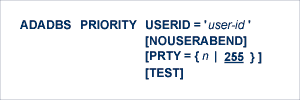





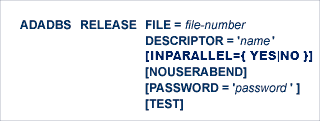
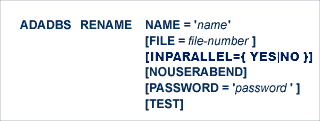


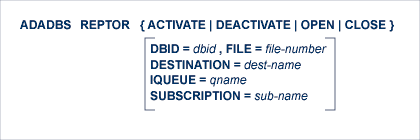






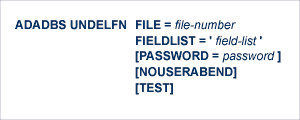

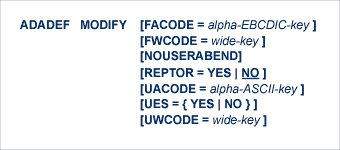

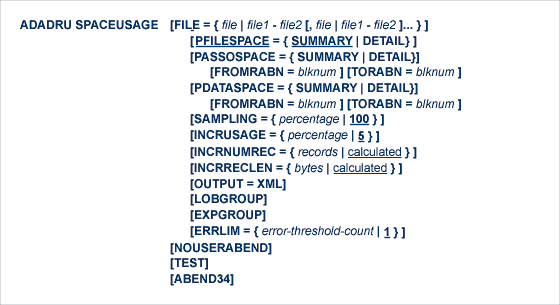
To format the Associator (ASSO) or Data Storage (DATA) data sets, use this syntax:

To format the Work (WORK), command log (CLOG), protection log (PLOG), or sort (SORT) data sets, use this syntax:

To format the recovery log (RLOG), use this syntax:
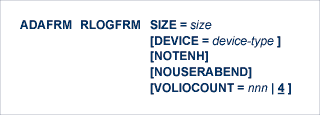
To format the Temp (TEMP) data set, use this syntax:
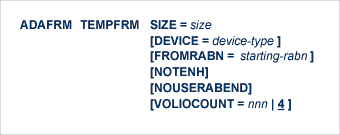
To reformat blocks of an existing Associator, Data Storage, or Work data set, use this syntax:
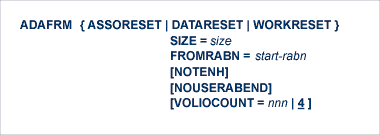
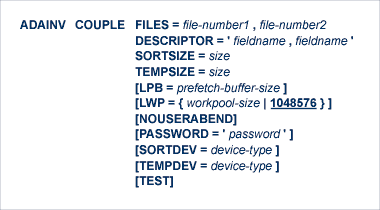
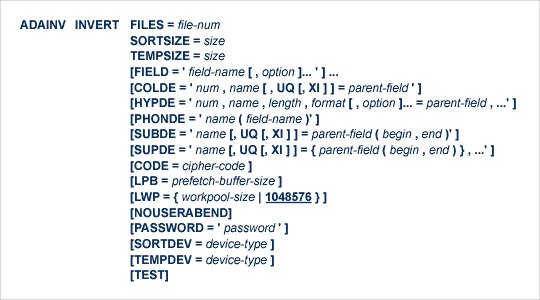
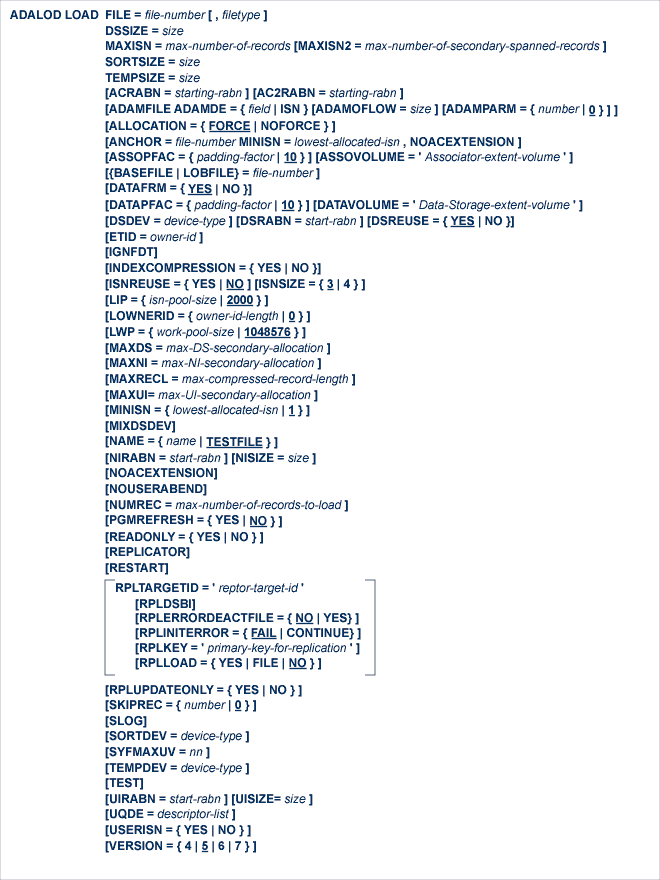
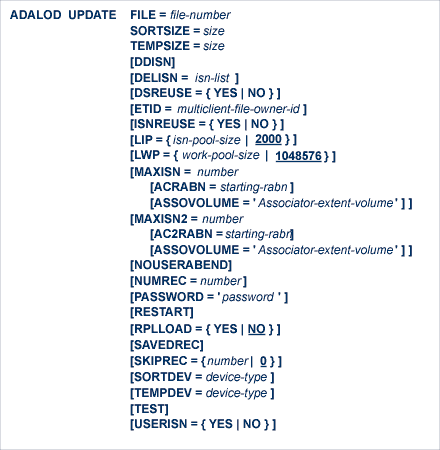
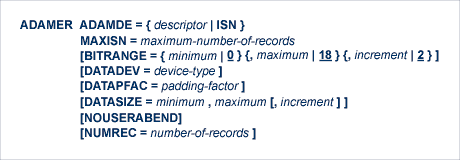
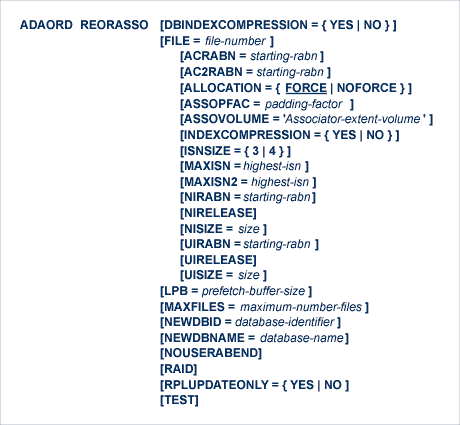
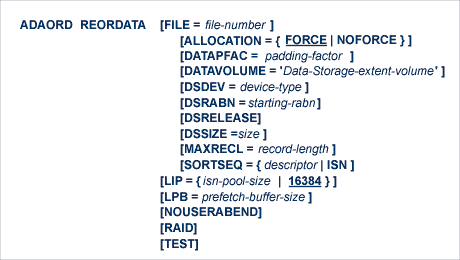

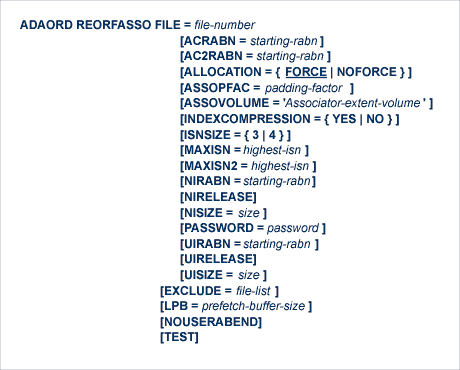
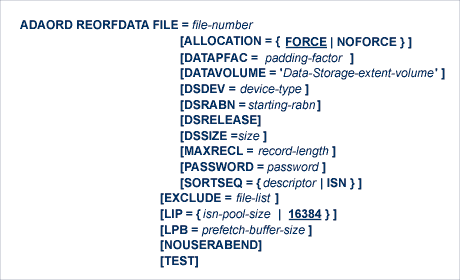
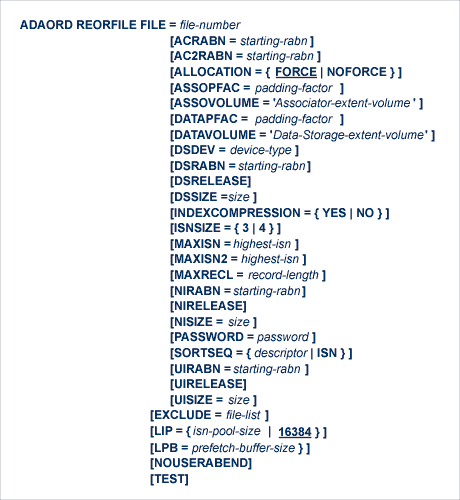
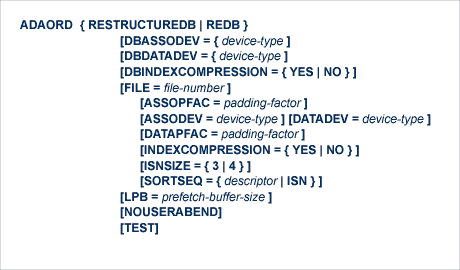
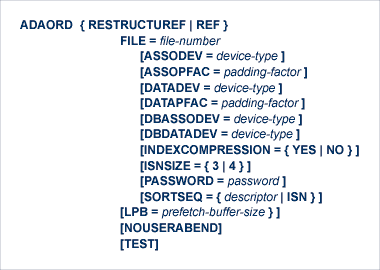
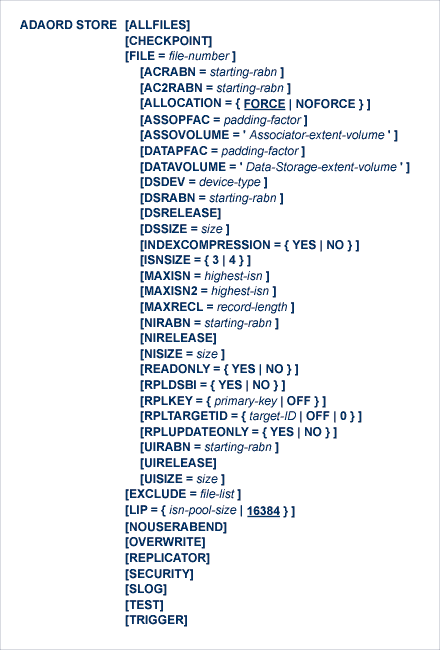
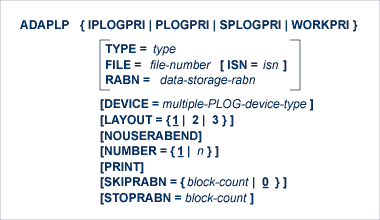
where type is one of the following:
